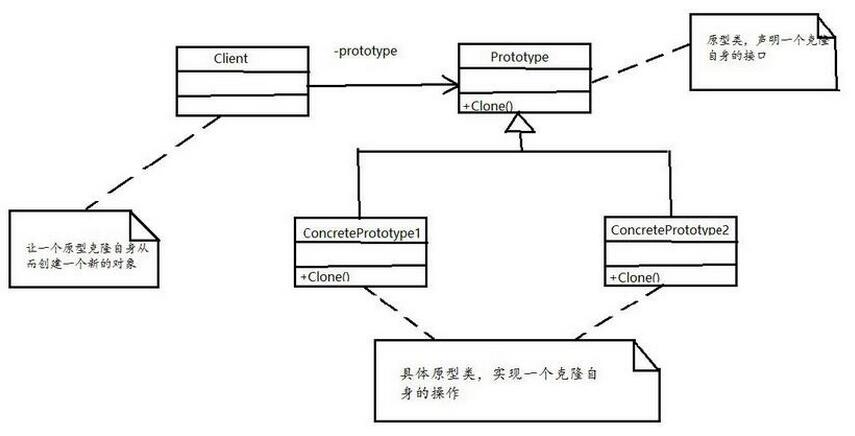
プロトタイプパターンの定義:
プロトタイプインスタンスを使用して、作成するオブジェクトのタイプを指定し、これらのプロトタイプをコピーして新しいオブジェクトを作成します。
プロトタイプ モードの構造図:

作成モードの特別なモード - プロトタイプ モードの最大の機能の 1 つは、既存のオブジェクトのクローンを作成することです。1 つは浅い度数のコピーです。もう一つはディープコピーです。
クリエイティブ モードは通常、新しいオブジェクトを作成するために使用され、その後、このオブジェクトを使用していくつかのオブジェクト操作を完了します。オブジェクトの作成を迅速に完了するための特別な new() 操作を提供しなくても、プロトタイプ モードを通じてオブジェクトを迅速に作成できます。新しいオブジェクトを素早く作成するための非常に効果的な方法であることは間違いありません。
1. プロトタイプ モード: 浅いコピー
すべてのカラー オブジェクト インターフェイスを表現するインターフェイスを定義します
/// <summary>
/// 颜色接口
/// </summary>
public interface IColor
{
IColor Clone();
int Red { get; set; }
int Green { get; set; }
int Blue { get; set; }
}
red の特定の実装コードを指定します:
public class RedColor:IColor
{
public int Red { get; set; }
public int Green { get; set; }
public int Blue { get; set; }
public IColor Clone()
{
return (IColor)this.MemberwiseClone();
}
}
具体的なテスト コードは次のとおりです:
static void Main(string[] args)
{
IColor color = new RedColor();
color.Red = 255;
Console.WriteLine("color -red " + color.Red); //225
IColor color1 = color.Clone();
color1.Red = 224;
Console.WriteLine("color1-red " + color1.Red);//224
Console.WriteLine("color -red " + color.Red); //225
}

color1 オブジェクトの Red 属性値を変更しても、color 属性には影響がないことがわかります。つまり、オブジェクトのコピーの変更は、オブジェクトの状態に影響を与えません。オブジェクトそのもの。
2. プロトタイプ モード: ディープ コピー
ディープ コピーで考慮される状況は、オブジェクト間に継承または参照関係がある可能性があるため、比較的複雑であり、一般的に、ディープ コピーでは次のことが可能です。一方では単純なディープコピースキームであり、他方ではオブジェクトをシリアル化の形式でコピーすることもできます。プロトタイプ モードは、以下のシリアル化の形式で実装されます。
using System;
using System.Collections.Generic;
using System.Linq;
using System.Text;
namespace ConsoleApplication4
{
/// <summary>
/// 颜色接口
/// </summary>
public interface IColor
{
IColorDemo Clone();
int Red { get; set; }
int Green { get; set; }
int Blue { get; set; }
Factroy f{get;set;}
}
/// <summary>
/// 生产颜色的工厂信息
/// </summary>
[Serializable]
public class Factroy
{
public string name { get; set; }
}
}
using System;
using System.Collections.Generic;
using System.Linq;
using System.Text;
namespace ConsoleApplication4
{
/// <summary>
/// 颜色
/// </summary>
[Serializable]
public class RedColor:IColor
{
public int Red { get; set; }
public int Green { get; set; }
public int Blue { get; set; }
public Factroy f { get; set; }
public IColor Clone()
{
SerializableHelper s = new SerializableHelper();
string target = s.Serializable(this);
return s.Derializable<IColor>(target);
}
}
}
シリアル化ヘルパー クラス:
/// <summary>
/// 序列化和反序列化辅助类
/// </summary>
public class SerializableHelper
{
public string Serializable(object target)
{
using (MemoryStream stream = new MemoryStream())
{
new BinaryFormatter().Serialize(stream, target);
return Convert.ToBase64String(stream.ToArray());
}
}
public object Derializable(string target)
{
byte[] targetArray = Convert.FromBase64String(target);
using (MemoryStream stream = new MemoryStream(targetArray))
{
return new BinaryFormatter().Deserialize(stream);
}
}
public T Derializable<T>(string target)
{
return (T)Derializable(target);
}
}
テスト:
static void Main(string[] args)
{
IColor color = new RedColor();
color.Red = 255;
color.f = new Factroy() { name="湖北工厂" };
Console.WriteLine("color - Factroy:" + color.f.name); //湖北工厂
IColor color1 = color.Clone();
color1.Red = 234;
color1.f.name = "北京工厂";
Console.WriteLine("color1- Factroy:" + color1.f.name); //北京工厂
Console.WriteLine("color - Factroy:" + color.f.name); //湖北工厂
Console.Read();
}
プログラムの実行結果は次のとおりです。

結論: 新しいオブジェクトはシリアル化と逆シリアル化を通じて形成されます。実際、プロジェクト内のオブジェクトのコピーにプロトタイプ モードが使用されている限り、シリアル化の形式でディープ コピーを実行できます。